How the Red Army liberated Krasnodar and Rostov-on-Don
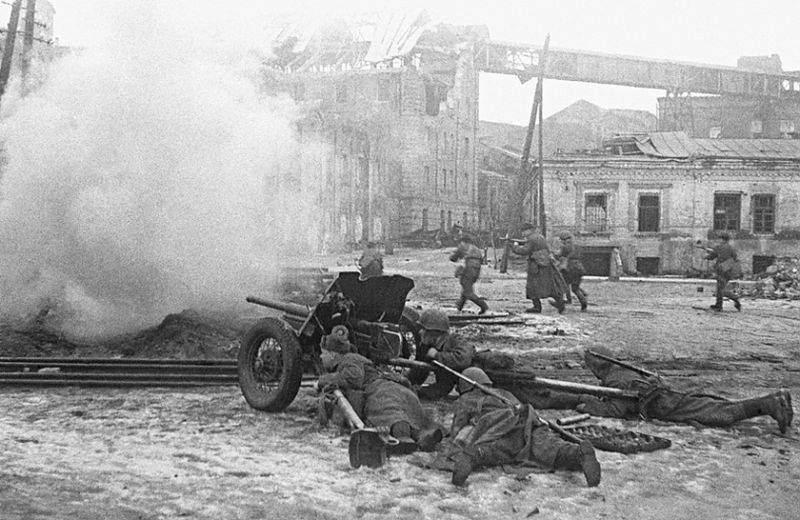
Artillery crew of a 45-mm gun supports the attack of Soviet soldiers near the station in Rostov-on-Don. February 14, 1943
Withdrawal of the 1st Panzer Army from the North Caucasus
The commander of Army Group "Don" Manstein saw that the collapse of the front section where the Italians and Hungarians were defending (The defeat of the Ostrogozhsk-Rossoshan group on the Upper Don), and the lack of reserves leads to the encirclement of army groups "A" and "Don". The only salvation is the withdrawal of troops from the Caucasus and the rapid transfer of the 4th tank army from the area south of the Don to the area of the middle reaches of the Don.
However, the German headquarters did not share this opinion. Hitler did not want to give up the foothold in the Caucasus. However, in the end, the Fuhrer realized that he would have to say goodbye to Maykop oil. Manstein suggested that if the situation in the Voronezh direction did not come out, then the Donbass should also be left. Hitler was against it, believing that the Reich needed the Donbass in military and economic terms.
On January 24, 1943, the German headquarters made the final decision on the withdrawal of troops from the North Caucasus. Mackensen's 1st Panzer Army was withdrawn through Rostov to reinforce the Don group. Ruoff's 17th Army was to retreat to Taman, to gain a foothold, maintaining a foothold, and to pin down the Russians, waiting for better times. It was also decided to reduce the entire front line, the withdrawal of forces from the Rzhev-Vyazemsky and Demyansky bridgeheads.
On January 27, the 1st Tank Army was subordinated to the Don Group, and the divisions of the tank army, which were withdrawn through Rostov-on-Don, began to prepare for the transfer to the Middle Donets. Due to the hesitation of the high command in the Kuban, the 13th tank and 50th infantry divisions were left. The Rostov direction was still covered by the 4th Panzer Army of Hoth. On January 29, Manstein's headquarters moved from Taganrog to Stalino (now Donetsk). Manshten proposed to strike at the Russians in the Kharkov direction.
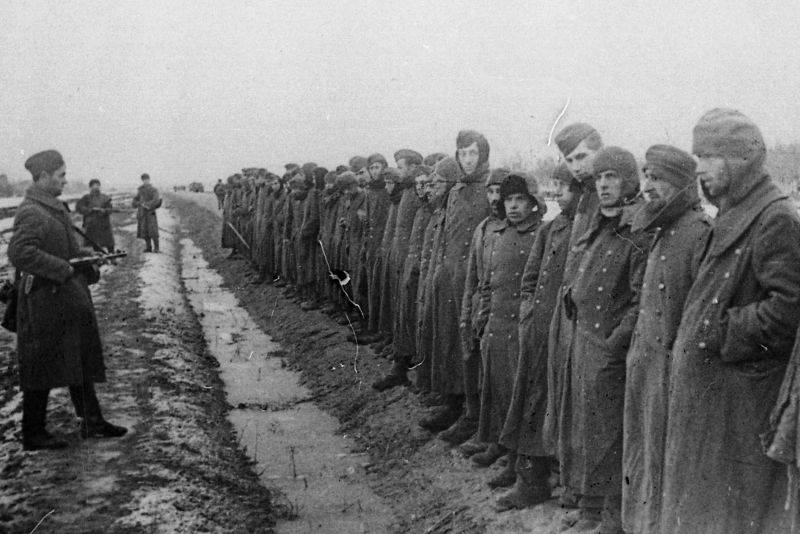
German soldiers captured during the liberation of Krasnodar. February 1943
The North Caucasus
On January 24, 1943, the Northern Group of the Transcaucasian Front was transformed into an independent North Caucasian Front (SKF). It included the 9th, 37th, 44th and 58th armies, the Kuban and Donskoy guards cavalry corps. General Maslennikov remained in command. The Stavka ordered the SCF to send the cavalry-mechanized Kirichenko group to Bataysk to strike behind enemy lines, to capture Bataysk, Azov and Rostov together with the left wing of the Southern Front. The 44th and 58th armies advanced in the direction of Tikhoretskaya - Kushchevskaya with the aim of defeating the retreating troops of the German 1st tank army, reaching the Bataysk - Azov - Yeysk line. The 9th Army attacked Timashevskaya, the 37th Army attacked Krasnodar in order to defeat the Krasnodar enemy grouping together with the Black Sea group.
The command of the Black Sea group of General Petrov was no longer assigned the task of breaking through to Tikhoretskaya, there was no point. They were supposed to liberate Novorossiysk and the Taman Peninsula, to prevent the enemy from leaving for the Crimea. The next task was to capture the Kerch Peninsula.
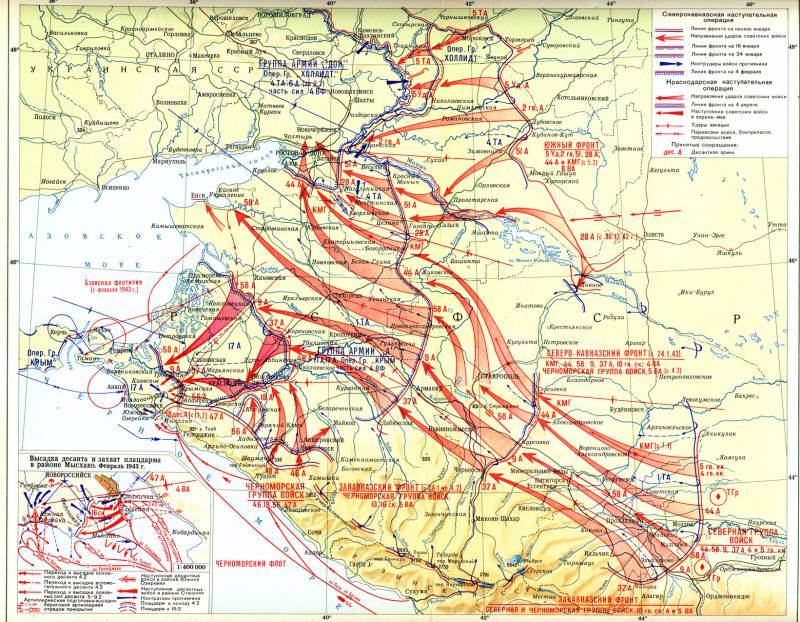
The Black Sea group at the first stage was unable to complete the tasks of liberating Krasnodar, further breakthrough to Tikhoretskaya and the occupation of Novorossiysk (Operations "Mountains" and "Sea"). The offensive of the 47th Army, which delivered the main cutting blow to the villages of Abinskaya and Krymskaya in the general direction of Temryuk, bogged down. Commander Kamkov was removed and sent to study at the accelerated courses of the Military Academy of the General Staff (the army was no longer entrusted to him). In his place on January 25, General Leselidze was appointed (before that he commanded the 46th Army). From January 26, the 47th Army stormed the positions of the German 5th Army Corps for a week, but without noticeable success.
The 46th Army, which General Rosly accepted after Leselidze, continued to pursue the retreating enemy. Our troops liberated Neftegorsk, Apsheronsky and Maikop. On February 2, 1943, the Red Army crossed the Kuban, capturing Ust-Labinskaya. Two days later, Rosly's troops linked up with units of the 37th Army of the SCF.
On January 18, Ryzhov's 25th Army drove out the enemy's rearguards from Neftyanaya and Khadyzhenskaya, reaching the Kuban River by the end of the month. However, it was not possible to force the river on the move. As Grechko noted, a successful offensive was hampered by poor command and control of the army. Already on January 23, the command and control of the army troops was disrupted, and from January 27 to the beginning of February it was completely lost. Also, during the offensive, almost all the reinforcement artillery remained in the mountains. Military artillery and mortars kept up, but there was no ammunition for them. The problem of supplying troops in the conditions of the Caucasus has not disappeared.
The 56th Army of Grechko, with the help of the 10th Guards Rifle Corps and the 76th Naval Rifle Brigade, supported by partisan detachments converted into fighter battalions, fought for Goryachiy Klyuch until the end of January, trying to break through to Krasnodar. But here the Germans did not plan to retreat. Krasnodar was an important railway junction, the main supply base for the 17th Army, while the Kerch Strait was ice-bound. Therefore, the German 44th Army Corps held out despite the fierce attacks of Grechko's troops.
On February 2, the Soviet Headquarters ordered to supplement the unsuccessful frontal attacks of the 47th Army with a flank attack by the 56th Army on the Crimean, and the 18th Army was aimed at taking Krasnodar from the north. However, the Germans fought back successfully. In the next three days, the troops of the 18th and 46th armies advanced slightly.
On February 5, 1943, the Black Sea Group of Forces became part of the North Caucasian Front, retaining its structure. Its main task was to defeat the Krasnodar-Novorossiysk enemy grouping. The Transcaucasian Front now guarded the Black Sea coast, covered the border with Turkey and controlled the situation in Iran.
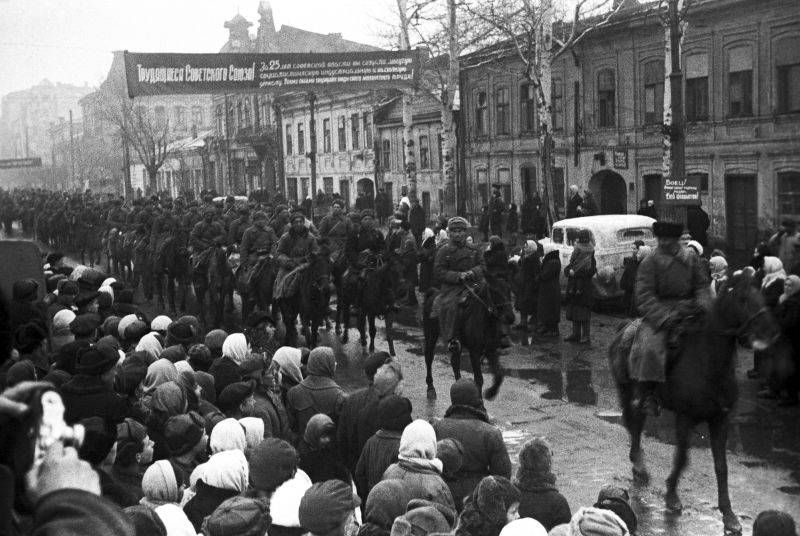
Residents of the liberated Rostov-on-Don meet Soviet horsemen. February 1943
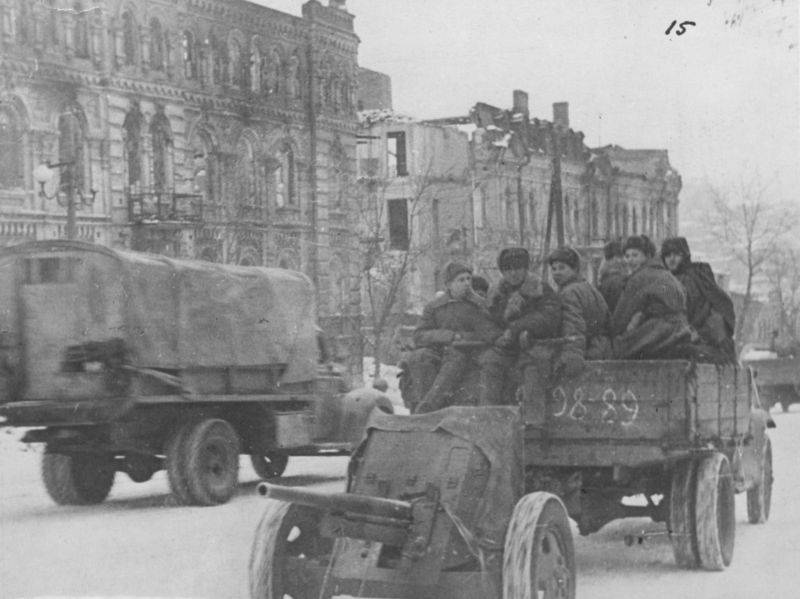
Red Army soldiers in the back of a truck are driving down Engels Street in the liberated Rostov-on-Don. A 45-mm anti-tank gun model 1937 (53-K) was hooked to the truck
Malaya Zemlya
The amphibious assault in the Novorossiysk region was conceived by the Soviet command in November 1942. Then the landing became part of the "Sea" plan. After the troops of the 47th Army failed to take Krymskaya and create a threat to the enemy in Novorossiysk from land, General Petrov decided to launch a landing operation. February 4, 1943 by the forces of the Black Sea fleet amphibious assault was landed in the Novorossiysk region. During stubborn battles, the bridgehead was expanded to 28 km², and reinforcements were landed on it, including units of the 18th Army.
On February 4–15, 1943, a landing operation was carried out in the Novorossiysk region. Its purpose was to assist the troops advancing north. It was planned to land the main landing in the area of Yuzhnaya Ozereyka, the auxiliary - on the western shore of the Tsemesskaya Bay, in the suburbs of Novorossiysk - Stanichki. The landing was provided by ships of the Black Sea Fleet. From the air, the operation was supported by aircraft of the Black Sea Fleet (more than 130 aircraft) and the 5th Air Army (30 aircraft).
On the night of February 4, landing began in the designated areas. However, due to a strong storm, it was not possible to land the main landing force in full force in the area of Yuzhnaya Ozereyka. Events unfolded more successfully in the area of the auxiliary landing. The detachment of Caesar Kunikov was able to occupy a small foothold in the Stanichki area. Together with the troops, the partisans of I. Vasev landed on the bridgehead. Auxiliary landing became the main one. The bridgehead was expanded to 4 km along the front and up to 2,5 km in depth. Subsequently, it received the name "Malaya Zemlya" - a piece of land on the western shore of the Novorossiysk (Tsemesskaya) bay and the southern outskirts of Novorossiysk. Here, from February 4 to September 16, 1943, there were extremely fierce battles.
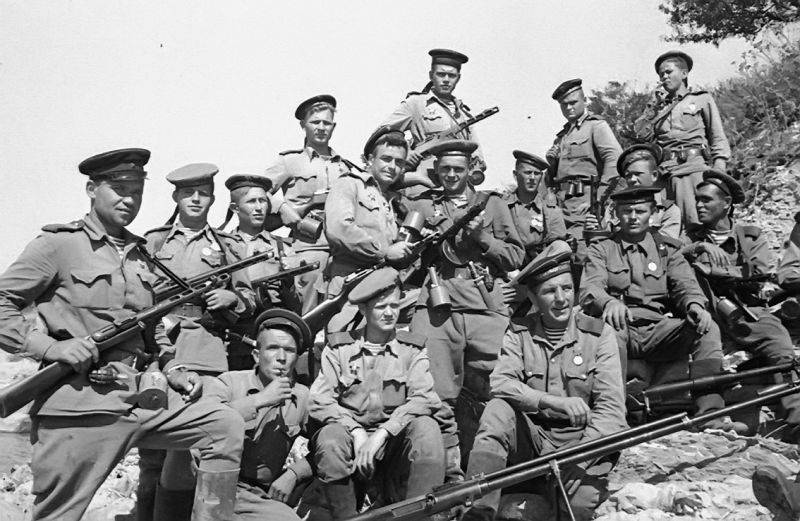
Marines from the detachment of Major Ts. L. Kunikov, shortly before, on the night of February 4, 1943, they took part in the landing operation and captured the bridgehead south of Novorossiysk, which was called the Malaya Zemlya. Of these, after landing, only three survived. Far left - Kirill Dibrov (later he took part in the Kerch landing operation, was awarded the title of Hero of the Soviet Union), the second in the last row - Vladimir Kaida, and Otari Janiani - with a grenade in the center.
Liberation of Rostov and Krasnodar
The SCF troops were more successful as the Germans withdrew towards Rostov. The armies of the left wing pushed back parts of the German 17th Army to the area northeast of Krasnodar. On January 24, our troops liberated Armavir, on January 30 - Tikhoretskaya. The 58th Army of General Melnik reached the Taganrog Bay in the Yeysk region. The 44th Army and KMG reached the approaches to Rostov from the south. But Mackensen's tank army had already slipped out of the trap. The 17th Army continued the defense of the Kuban line. For exemplary flight, Hitler awarded von Klest the rank of field marshal.
Neither Bataisk nor Rostov were taken by the Soviet troops on the move. On February 7, the Soviet army took Bataysk. The Germans left Rostov on February 13, 1943. German troops entrenched themselves on the Mius River.
On February 9, SCF troops launched an offensive against Krasnodar. The greatest success in the first days of the offensive was achieved by the 37th Army, which managed to create a threat to the Germans near Krasnodar. On February 12, Krasnodar was liberated by the forces of the 12th and 46th Soviet armies. The German command began to withdraw its troops to the Taman Peninsula. The German 17th Army entrenched itself on a new line of fortifications - the so-called. blue line. Fighting continued here until September 1943.
Thus, Army Group A was forced to leave the North Caucasus, retreating through Rostov and to Taman. The 17th Army - 17 divisions, about 400 thousand people, was isolated from the main forces of the Wehrmacht. The Germans continued to fight on the Kuban (Blue) line.
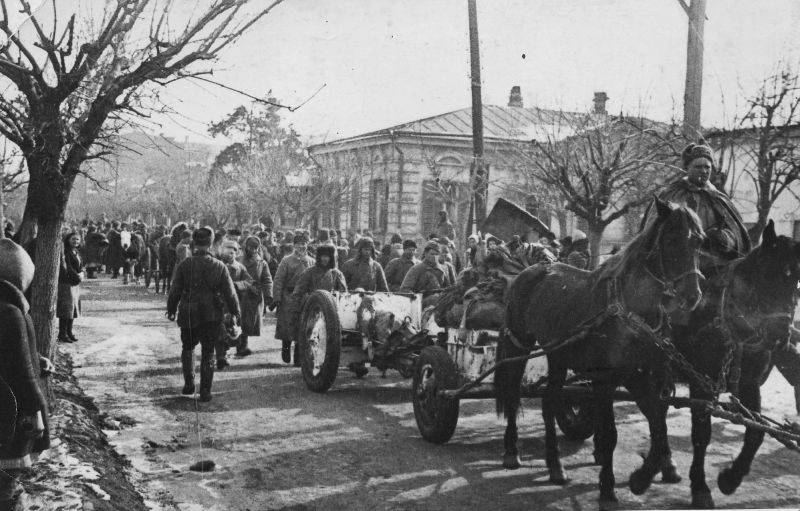
The 2nd Guards Rifle (future Tamanskaya) Division enters the liberated Krasnodar. February 12, 1943
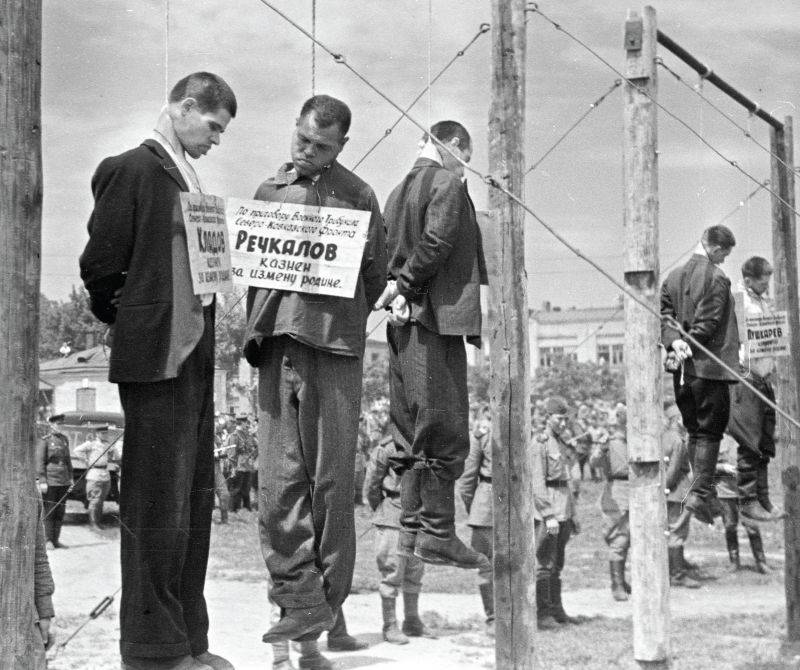
Soviet collaborators executed in Krasnodar who served in the Einsatzkommando 10a, which carried out punitive operations against civilians in the Krasnodar Territory in the zone of action of the 17th Wehrmacht Army. The Einsatzkommando was led by SS-Obersturmbannführer Kurt Christmann and had up to 200 men in total. It was the world's first open trial of Nazi collaborators. At the trial in Krasnodar on July 14–17, 1943, members of Einsatzkommando 10a and their assistants were accused: Kladov, Kotomtsev, Lastovina, Misan, Naptsok, Pavlov, Paramonov, Pushkarev, Rechkalov, Tishchenko, Tuchkov. The chairman of the court was Colonel of Justice Mayorov, a representative of the Military Tribunal of the North Caucasian Front, the public prosecutor was Major General of Justice Yachenin. The defendants were defended by three court-appointed lawyers. To prove guilt, the acts of the ChGK were quoted, 22 witnesses were heard, the conclusions of the medical examination on the autopsy of 623 corpses (85 children, 256 women and 282 men, including 198 old people) were read out, of which 523 residents died from gases, 100 from shots in head. Under the burden of evidence, all the defendants fully pleaded guilty to complicity with the German invaders, to atrocities against the population of Krasnodar and the Krasnodar Territory. The military tribunal sentenced the main executioners to death by hanging: Tishchenko, Rechkalov, Lastovina, Pushkarev, Misan, Naptsok, Kotomtsev and Kladov. The sentence was carried out on July 18 at 13:30 on the city square of Krasnodar. The execution was watched by 50 to 20 thousand residents of the city and nearby villages. On the condemned hung a sign "Executed for treason." Less active accomplices Tuchkov, Pavlov and Paramonov received 1943 years in labor camps. July XNUMX
- Alexander Samsonov
- https://ru.wikipedia.org/, http://waralbum.ru/
Information